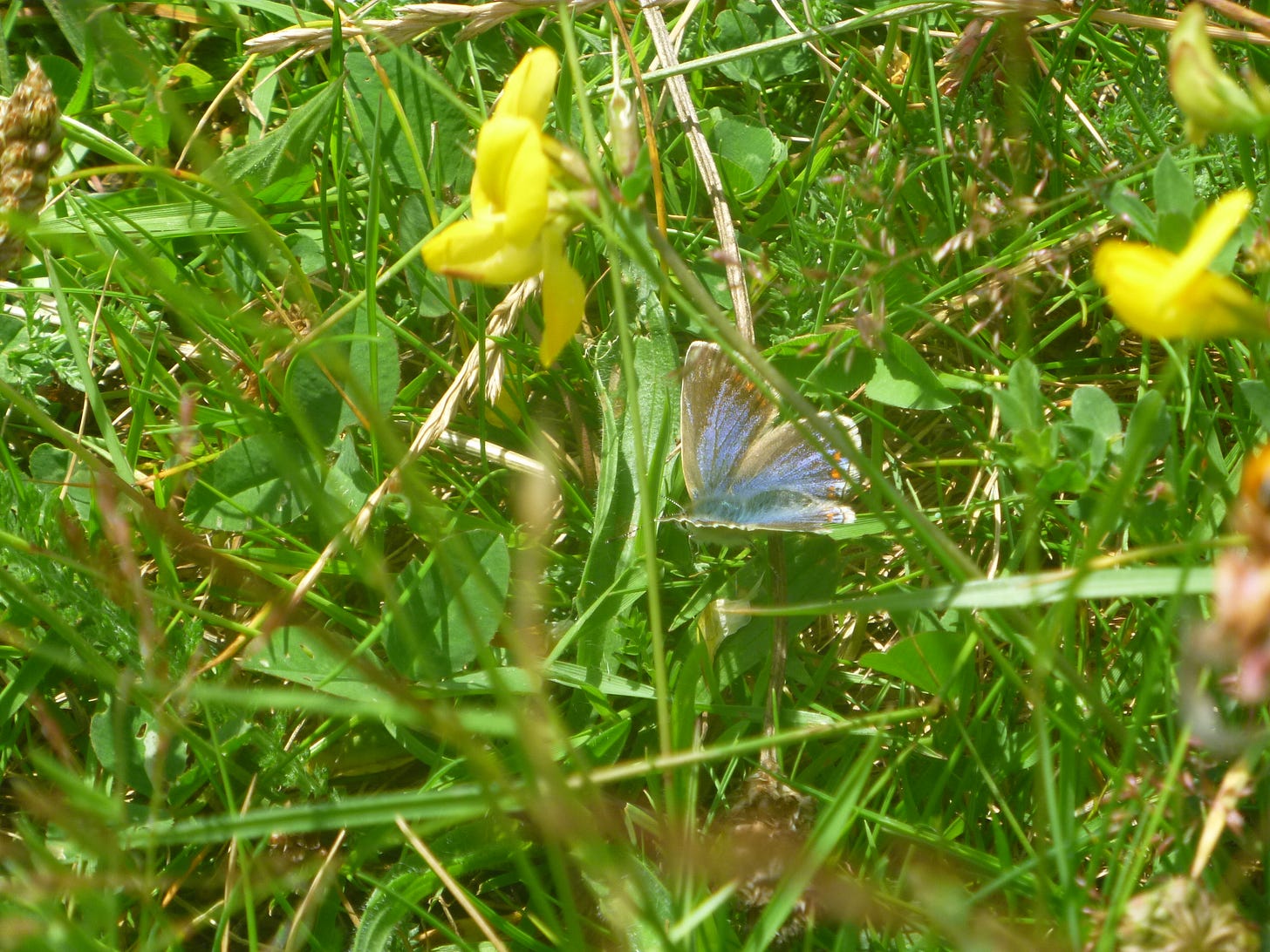The weekend before last, we had a lovely walk at Musselburgh on the East Lothian coast. For a naturalist, the special appeal of Musselburgh, particularly in winter, lies in the Ash Lagoons, that were formed from ash dumped from the nearby Cockenzie Power Station, but that have been landscaped to form shallow lagoons that attract large numbers of birds, specially waders in winter, and wildflower meadows that are attractive to butterflies. On the day we visited, we were delighted to see so many butterflies, especially this female Common Blue,
The underside of her wings are even more beautiful
Despite its name, the Common Blue is not particularly common around Edinburgh (Musselburgh is one of the few places where I’ve ever seen this species). We saw so many butterflies on our visit, that I decided to try to visit here for a survey for the Big Butterfly Count, which, this year, will happen between Friday 18th July and Sunday 10th August. Launched in 2010, the Big Butterfly Count is a UK-wide citizen science survey and is now the world's largest survey of butterflies. Butterflies are vital pollinators and are important food for many other species. Sadly, numbers of butterflies and moths in the UK have declined significantly since the 1970s. In fact, the Butterfly Conservation charity declared a butterfly emergency as a result of the survey results of the 2024 Big Butterfly Count. So, if you’re in the UK, it’s particularly important to take part in this year’s survey, to enable Butterfly Conservation to gather as much information as they can to inform conservation of butterflies in the country.
For the past few summers I’ve been surveying butterflies for the UK Butterfly Monitoring Scheme, in two locations in Edinburgh. I’ve noticed that numbers of most species have actually increased slightly since last year, which is good, but they’re still down on what you would have seen years ago. You can read more about my experiences surveying butterflies in the article below. (Please note that as the post below was written a year ago, and mentions optimism about the environmental credentials of the then new UK Government, optimism that has proven to be largely misplaced).
Butterfly Surveying
Hello again! This post would have appeared last week, except that I wanted to say something about the environmental implications of the results of the recent UK General Election (you can read that post here).
I mentioned above that surveying butterflies can help to inform conservation measures to secure the future of declining species. I really like this story, reported in The Guardian, of how prisoners are helping to conserve an endangered butterfly in a US prison.
Moths are the often underappreciated cousins of butterflies. Many moths are nocturnal and so less frequently seen, and many of them are small and difficult to identify, so are more of a specialist area than the generally more brightly coloured, day flying butterflies. However, if you keep you eyes out there are many beautiful moths to be seen during daylight hours. In our recent trip to Musselburgh, we were very happy to see this Six-spot Burnet Moth
National Moth Week is an international opportunity to celebrate moths. People across the world are invited to take photos of moths and share them to share the wonder of these insects.
Subscriptions Update
I’ve now enabled paid subscriptions, as two readers had already pledged their support (thank-you so much!) My articles will remain free for everyone to read, but I hope to offer benefits to paid subscribers, such as at some point enabling chat for paid subscribers and occasional giveaways.
Join the Campaign
Redhall Walled Garden is a therepeutic garden, run by SAMH (Scottish Association for Mental Health) which is threatened with funding cuts. Sign the petition urging the Edinburgh Integrated Joint Board to oppose funding cuts to mental health services in the city chng.it/2H8mTRBWyB
Interesting Articles
National Insect Week: Rare Invertebrates in the Cairngorms from the RSPB (Royal Society for the Protection of Birds)
Why are Some of Britain’s Ancient Woods Failing to Regenerate? by Patrick Greenfield in the Guardian.
Join In!
National Marine Week (26 July - 10 August) celebrates the seas around the UK. This year the theme is ‘Secrets of our Seabeds’









Interestingly, the (European Common Blue) is one of the most frequently encountered species here west of Montreal. As far as I have learned they arrived here first about a decade ago having probably arrived on a plane from Europe at Mirabel airport north of the city ... they seem to have liked what the found and are spreading happily.
https://www.inaturalist.org/projects/european-common-blue-butterflies-montreal?tab=about
I had a nasty moth experience as a child, but I’ve come to appreciate them as an adult. I generally do butterfly count. Last year was quite bad here but this year is much better.